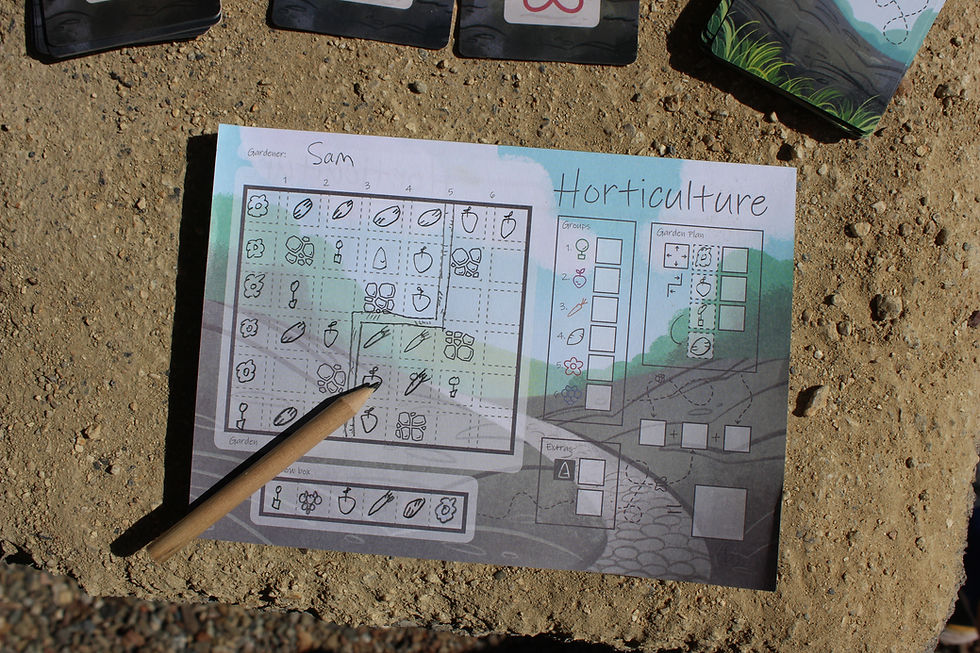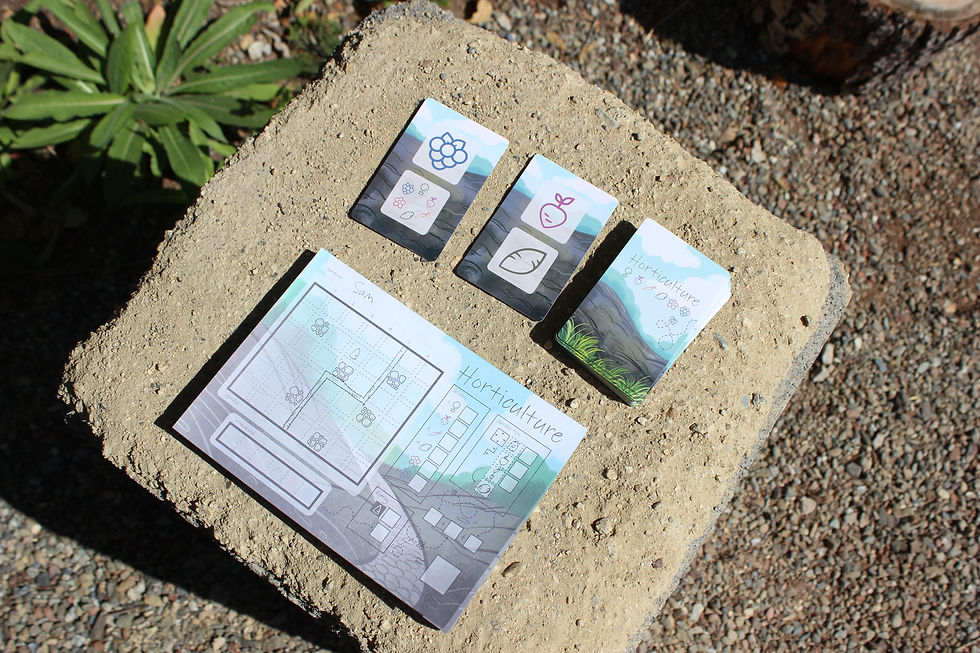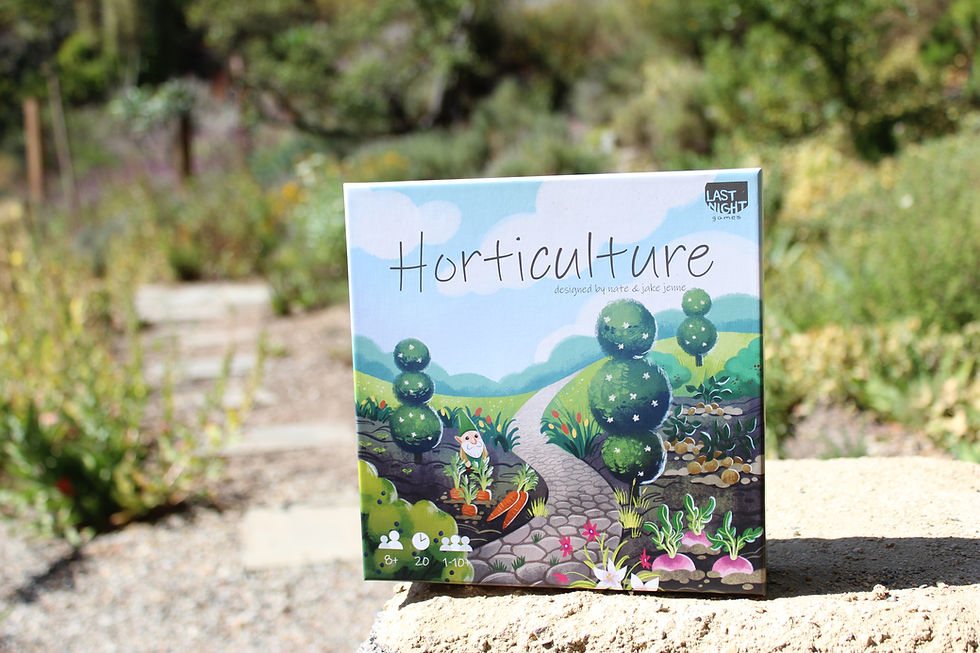Designers: Nathan Jenne and Jake Jenne
Publisher: Last Night Games
Player Count: 1 to 10+ Players
Play Time: 20 Minutes
In this review of Horticulture, I highlight how-to-play, strategy, and the importance of beat-your-own-score style solo games to have above-and-beyond replayability.

Horticulture from Last Night Games is a light, fast-paced flip-and-write—meaning players will flip cards and draw their garden according to what is on the cards—game about planting a garden. Players score points by arranging like-plants together and sticking to their garden plan. The player with the most orderly garden after all seeds are sowed is the winner.
Supporting one to eight players—and the designer has noted that the game can accommodate even more—Horticulture’s player capacity means that it should have appeal to diverse playgroups and fulfill several different gaming interests. It can be both a quiet, relaxing solo experience, or an easy-to-learn first game on a game night.
Gameplay
Before players can plant anything, they need to prepare their gardens. Each player gets a garden sheet containing a scoring area and a garden—a six by six grid in which players will be drawing all of their garden’s features, including a gnome, a path, and six different types of plants: topiaries, turnips, carrots, sweet potatoes, flowers, and berries.
First, each player picks a square in their grid for their garden gnome, drawing her hat into that space on the grid. Then, each player completes their unique garden plan, deciding which one of the six plant types they want to plant around the perimeter, which plant type they will arrange along the garden path, and two more plant types that they intend to arrange adjacent to one another throughout the garden Sticking to the garden plan will earn the player additional points for each drawn plant drawn that fulfills the stated condition.
No garden is complete without a path. Collaboratively, players will all draw an identical garden path that snakes in between grid squares, bisecting the garden from top to bottom. One player chooses the position of the first segment of the garden path and, going around the table, each player will decide the direction of the next segment until the path ends at the bottom of the grid. Plants on either side of the path are not adjacent to one another for scoring purposes.

Finally it is time to plant! Each turn, the active player will reveal the top two plant cards of the shared plant deck and select one of them, discarding the other. Each plant card shows two plant types; these could be two different plant types or two of the same. Player must draw the two plants shown on the chosen plant card into their gardens adjacent to the perimeter, the garden path, the garden gnome, or another plant. Players can also choose to draw plants into their window box—basically an overflow plot that can only hold one of each plant type. Players get to pick what plant type to draw when the plant card shows a wild plant symbol. Play proceeds around the table with one player flipping two cards and choosing one of them for everyone to draw until there are no cards left in the deck.
Players tally their scores beginning with the completed groups of each plant type. A group is complete when the number of contiguous, adjacent plants of the same type is equal to or greater than the target number for that plant type as shown on the score sheet. For example, a group of carrots is complete when there are at least three adjacent carrots drawn in the garden; scoring three points for the gardener. Each player will also score for each plant in their window box, score groups that are adjacent to the garden gnome an additional time, and score two points for each individual plant that fulfills one of the conditions of the garden plan. The gardener with the highest score after all math is double-checked is the winner.
Solo
Aside from ensuring that the correct number of plant cards are in the starting deck, there are no modifications to the game required for solitaire play. Setup and gameplay proceed the same as at a full table. Although nothing changes mechanically, I have found that solo Horticulture is a very different experience from multiplayer.
This is primarily due to how gameplay decisions—drawing the garden path and selecting which plant card is chosen each turn—that are normally subject to the whims and preferences of multiple players who have distinct garden setup positions—become solely the choice of the solitaire player. In other words, the game transforms from a shared process where each player needs to hazard the nonoptimal choices of the other players, to one where the solo player is the only one in the driver’s seat, with significantly more control over the shape and composition of their garden. This also means that solitaire gardens tend to score slightly higher than multiplayer ones.
Thoughts
Many solitaire gamers find solo games with a beat-your-high-score objective to be a little bit rote, especially ones with lighter strategy where there are fewer moving parts impacting the outcome of the game. In these cases, some gamers may find repetition is not about building skill and becoming better at the game through trial and error as much as it is merely tedious replay in a vain effort to one-up a previous playthrough. If a game is not equipped with changeable elements to keep gameplay fresh, it can be very easy to figure out the optimal play each turn towards an arcade-like high score.
However, it is exactly for that reason that others—myself included—regularly enjoy cozier, lighter solo games like Horticulture. Although I can appreciate the challenge that complex, gritty games that demand a steep learning curve pose, and relish at overcoming difficult trials and puzzles, sometimes I need to just draw plants in a garden over and over again. Excitement in a game need not come from inherent complexity, but can be creatively found in tranquil experimentation. Although there are few built-in elements adding replayability to Horticulture, the game includes enough variability and depends adequately on personal choice to make merely beating a high score far from monotonous; but the onus to add that flavor is left up to the player.

The flip side of the player sheet features a six by six garden like the one on the front, but instead of being a blank slate for sketching, six of the squares are voided by rocks in the soil that prevent the player from drawing anything in those spaces. This renders the garden a more challenging plot. Practically, this increases the difficulty of completing groups of plant types, especially ones that require larger contiguous adjacent plants to score, like flowers and berries. Fewer live squares means fewer plots where plants can be drawn.
However, the rocky board presents not just an increase in difficulty, but precedes a change in strategy as well, compelling me to adjust how I utilize the window box. Every plant in the window box will score one point at the end of the game, but if the player completely fills the box, an additional six points are also awarded. That could be 12 points just from the window box; not bad! On the standard side of the garden sheet, I normally draw one or two plants into the window box when they really did not fit anywhere in the garden. But with several squares unplayable on the more challenging side, drawing into the window box became a necessity, not only because I am prioritizing groups of plants that could realistically be completed, but because there simply are not enough live spaces to put all the plants that I need to draw. So filling the window box with one of each plant type becomes a worthwhile strategy to pursue as placement options run thin.
As mentioned earlier, in solitaire Horticulture the player is in total control of making garden design decisions in the game, namely drawing the garden path, devising their garden plan, and selecting between the two flipped plant cards each turn. This agency lends itself to purposeful creativity and self-imposed challenges. For instance, how challenging would it be to complete arrangements of plants if the garden path zig-zagged back and forth across the entire grid resulting in a labyrinth-like garden? What about choosing the same plant type to go along the perimeter and the garden path in the garden plan? What if the player randomly selected one of the two flipped plant cards each turn, rather than preferring the one that is always optimal for their garden? These elements of choice allow the player to make the game as simple and straightforward or eccentric and challenging as they want. If the player looks for them, Horticulture has clever ways of staying evergreen.
Overall I enjoy Horticulture for its quick rules-light gameplay, garden theme, and concise delivery—there’s really not much to it! When it comes to drawing games, I typically prefer ones with reusable components (white boards, chalk boards) over disposables, but I do appreciate how each garden sheet is double sided. Players seeking additional garden sheets don’t need to dig too deeply into Last Night Games’ website to find printables, but I suggest photocopying the ones that come with the game if you want the coloration as the file on the site is only in greyscale. Alternatively, laminate a few copies and keep them in the box and swap the pencils for dry erase markers.
For enthusiasts of games about gardening, I would plant Horticulture in the same row as other notable titles like Herbaceous, Miyabi, Reykholt, and other more recent games like Verdant and Garden Nation. As a flip and write title where the design and creation of the garden is as much about reticent drawing as it is strategic arrangement of components on the board, Horticulture makes a unique contribution to the expanding roster of games about organizing, growing, and cultivating plants in gardens, nurseries, and the like.











Comments